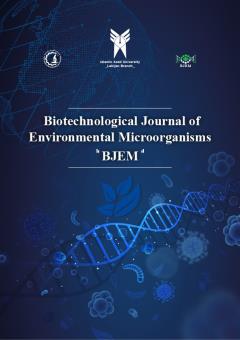Enhanced Antibacterial and Anti-Biofilm Activity of Green-Synthesized Silibinin-Functionalized Silica-Coated Fe₃O₄ Nanocomposites Against Staphylococcus aureus
Subject Areas : Biotechnological Journal of Environmental MicrobiologyNazanin Pasandideh Kordmahaleh 1 , Mirsasan Mirpour 2 , Mahdi Shariarinour 3 * , Najmeh Ranji 4 , Mohammad Nikpassand 5
1 - Department of Microbiology, La.C., Islamic Azad University, Lahijan, Iran
2 - Department of Microbiology, La.C., Islamic Azad University, Lahijan, Iran
3 - Department of Biology, Ra.C., Islamic Azad University, Rasht, Iran
4 - Department of Biology, Ra.C., Islamic Azad University, Rasht, Iran
5 - Department of Chemistry, Ra.C., Islamic Azad University, Rasht, Iran
Keywords: Silibinin, Green synthesis , Magnetic nanocomposite, Staphylococcus aureus , Vancomycin synergy , Biofilm inhibition,
Abstract :
Silibinin, a bioactive flavonolignan derived from Silybum marianum, possesses notable antibacterial, antioxidant, and hepatoprotective properties; however, its poor aqueous solubility restricts clinical applications. In this study, silibinin-functionalized silica-coated magnetic nanocomposites (Fe₃O₄@SPN@Silibinin) were synthesized via a green synthesis route to enhance solubility, stability, and antibacterial performance. The nanocomposites were comprehensively characterized using FTIR, TEM, FE-SEM, XRD, TGA, and VSM analyses, confirming uniform morphology (34–58 nm), high thermal stability, and ferromagnetic behavior with a saturation magnetization of approximately 30 emu/g. Antibacterial evaluation against Staphylococcus aureus (ATCC 25923 and clinical isolates) demonstrated potent inhibitory effects, particularly when combined with vancomycin. Checkerboard assays revealed a strong synergistic interaction, with a 4–16-fold reduction in the minimum inhibitory concentrations (MICs) of both agents. Furthermore, the combination significantly inhibited biofilm formation and accelerated bacterial killing, as confirmed by time-kill kinetics. These findings indicate that Fe₃O₄@SPN@Silibinin nanocomposites substantially enhance the antibacterial efficacy of vancomycin and effectively suppress biofilm-associated resistance mechanisms. The results highlight the promise of this green-synthesized nanoplatform as an efficient adjuvant strategy for managing multidrug-resistant S. aureus infections.
Hossainzadeh R, et al. (2019). Phytochemical and pharmacological properties of milk thistle (Silybum marianum).
Khakinezhad Tehrani H, et al. (2020). Silymarin as a bioactive flavonoid complex: A review.
Reed JL, et al. (2020). Botanical origins and medicinal importance of milk thistle.
Fallah M, et al. (2021). Therapeutic effects of silibinin on oxidative stress and inflammation.
Silybin and a Major (1942). Physicochemical characterization of silybin and its derivatives.
Lee J, et al. (2012). Bioavailability and pharmacokinetics of silibinin in animal models.
Murray PR, et al. (2015). Medical Microbiology. 8th ed. Elsevier.
Tuon FF, et al. (2022). Antibiotic resistance in Staphylococcus aureus: An updated review.
Chevalier S, et al. (2017a). Biofilm formation and virulence in S. aureus clinical strains.
Parham P, et al. (2020). Mechanisms of antibiotic resistance in Gram-positive bacteria.
Chevalier S, et al. (2017b). Functional properties of magnetic nanoparticles in biomedical applications.
Mouraki A, et al. (2018). Magnetic nanoparticles for drug delivery systems.
Aguilar Z, et al. (2007). Surface modification and applications of iron oxide nanoparticles.
Lee H, et al. (2014). Targeted drug delivery using magnetic nanoparticles.
Madhavi K, et al. (2015). Synthesis and stabilization of silica-coated Fe3O4 nanoparticles.
Dey S, et al. (2022). Nanocomposites as antibiofilm and antibacterial agents.
Ferreres I, et al. (2023). Nanomaterial-based inhibition of bacterial biofilms.
Fernández-Billón M, et al. (2023). Strategies for combating multidrug-resistant bacteria using nanotechnology.
Neidig A, et al. (2023). Innovations in antibacterial nanomaterials.

